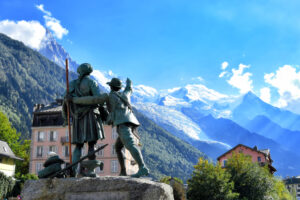In 2018, an oddly named publication called The Visual Capitalist published an article ranking countries by the differences between their lowest and highest points. The concept has recently found new life via social media. The graph basically measures the extremes of a country’s terrain by charting the altitude difference between its highest peak and its lowest point — often 0, or sea level.
By this yardstick, the world’s most rugged country is China, which ranges from 154m below sea level at the Turpan Depression in Xinjiang to 8,848m atop Mount Everest. Nepal and Pakistan rank two and three, respectively, followed by all the other countries that host one of the great ranges of the world — the Himalaya, the Karakorum, the Tien Shan, the Pamirs and the Andes. The United States ranks number 14 and spans from -85m in Death Valley to 6,190m at the top of Denali.
The number has relevance to adventure, because difficulty can relate to not just how high you go but how low you start from. For example, those tackling Mount Everest from Tibet enjoy a relatively comfortable drive to Base Camp at 5,200m, followed by an easy hike to an intermediate camp at 6,200m, then to Advanced Base Camp at nearly 6,500m. Only here, 2,348m from the top, does the climbing begin.

Nanga Parbat from Fairy Meadows, just one day below Base Camp. Photo: Imran Khakwani
Meanwhile, despite its slightly lesser altitude, 8,125m Nanga Parbat forces almost double the elevation gain, since a climber’s work begins at Base Camp at 3,900m on the normal Diamir side. Sure, it’s higher on Everest and the air is thinner, but you’re climbing up half the number of stairs, so to speak.
Moving from 8,000m peaks to local ones, we can figure out some homemade challenges based on altitude difference to help pass the new COVID lockdowns.
For instance, the highest point in this writer’s home country of Spain is not in the Pyrenees or the Sierra Nevada. It is 3,718m Mount Teide, a volcano on Tenerife in the Canary Islands. Athough a cable car can shuttle tourists to a point 20 minutes from the summit, those looking for a low/high challenge can begin beside the ocean at Playa del Socorro, hike 26km through terrain varying from black sand beach to misty pine forests to lava barrens and the still smoky crater, in a long day hike. Further ideas are welcome in the Comments section below.

The upper slopes of Mount Teide, the roof of the Canary Islands (and Spain). Photo: Antonio Fernandez






